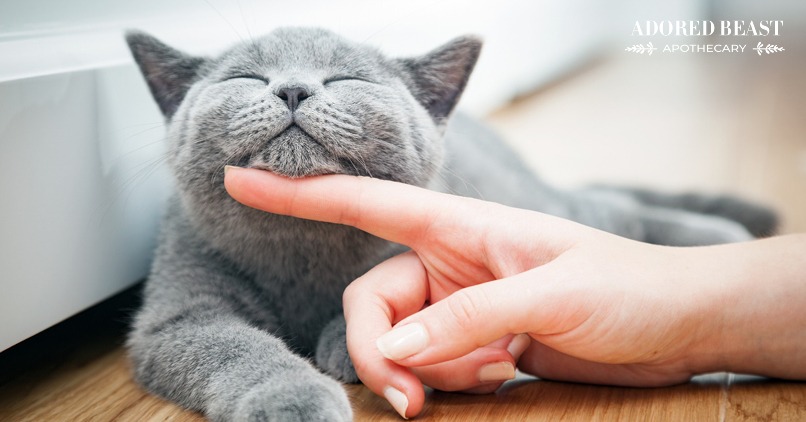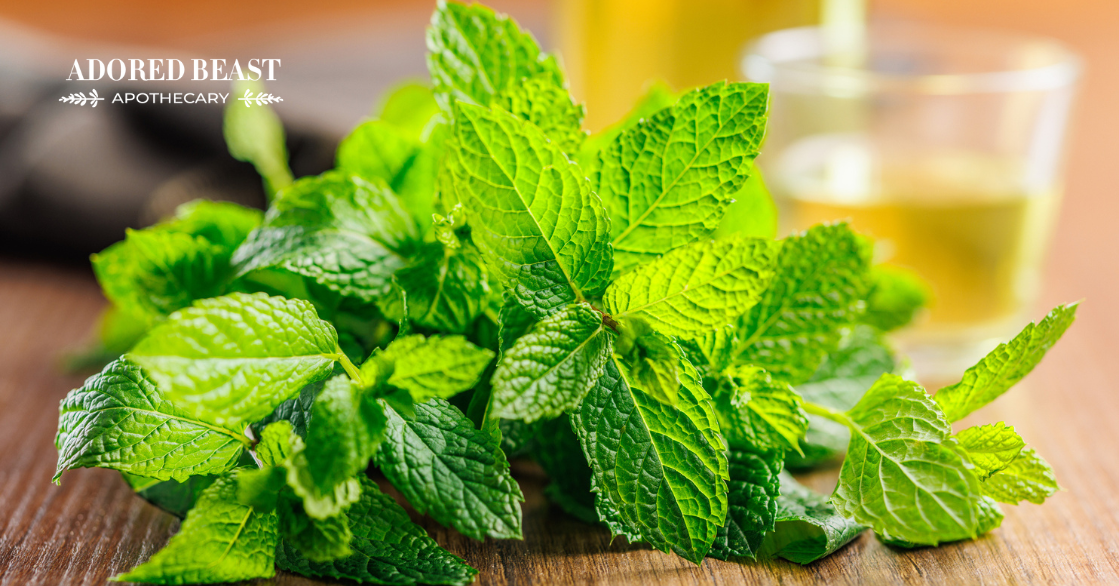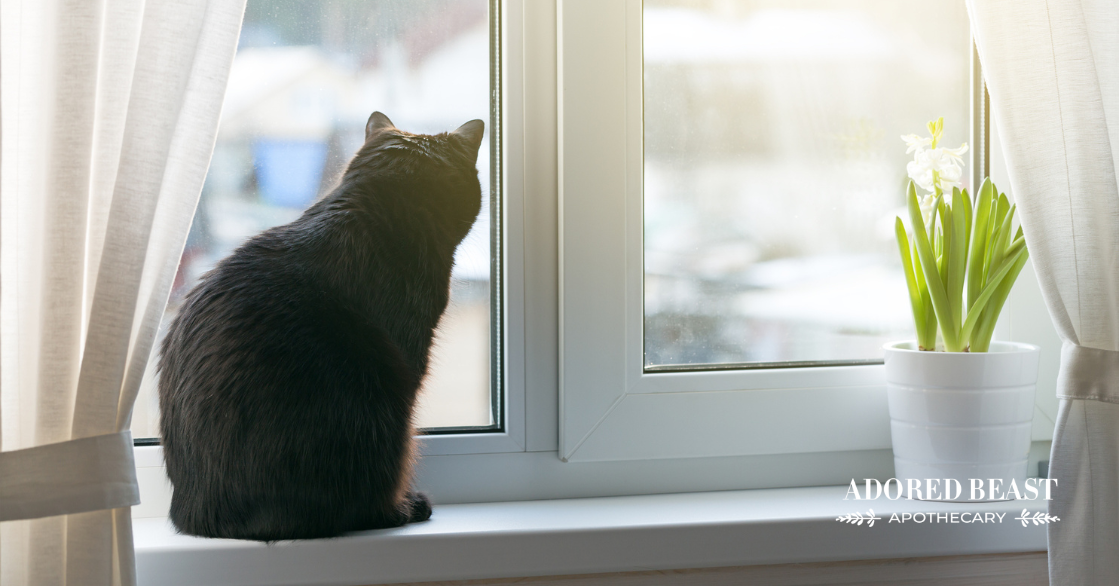Here at Adored Beast Apothecary, we get questions all the time about cat vomit. People come to us asking why it happens, what it might mean. And of course, what they can do to help their kitties.
So, we sat down with Adored beast Founder Julie Anne Lee to get the skinny on cat vomit. She told us some of the reasons why a cat might be throwing up, the simple things we could be doing to help curb the vomiting, and when it’s time to head to the vet.
Cat Vomit: Why Does it Happen?
Q: Why do cats vomit?
So many different reasons. Cats can vomit from anything from food sensitivities to inflammatory bowel disease, to eating dry food, not having enough digestive enzymes, to an inappropriate or non-species appropriate bowl or plate. They can vomit from fur balls, they can vomit from stress, so many different things.
Different Types of Cat Vomit and What They Mean
Q: If your cat vomits, what do the different colours mean? For example, yellow bile, or white foam, or fur balls?
Fur balls
Let’s start with fur balls because that’s the thing that we see the most. So fur balls can present in a couple of different ways. One would be, obviously, liquid with a piece of fur in the middle of it, or a piece of fur with liquid around it. That’s a good sign. When you’re seeing them come up like that, then your cat’s actually getting rid of their fur balls.
When you see vomit with just foamy white, or you see vomit with a sort of slime around it, but just little pieces of fur, that can often mean that there’s a fur ball that they can’t get out, one that’s sort of semi-obstructed. That’s a bigger issue. You’ll hear them coughing, and sometimes trying to vomit up the fur ball but it not coming out.
So, if you’re seeing a fur ball but your cat’s acting normal, remember that fur balls are a fairly natural thing, especially for cats that overgroom or groom each other. Often you’ll see fur balls with cats that are even on raw food diets when you have a more than one cat household. If they tend to groom each other, then sometimes you’ll see fur balls more often.
Bile
If you see vomit with bile in it, that’s a bit more concerning for sure. That means that there’s something going on with the liver, or the pancreas, or the portal system on some level, but usually the liver. And that’s more reason for concern because it can often mean there’s a deeper disease or a deeper pathology happening.
Vomiting Food
Cats that vomit their food, when you actually see their food in their vomit, that’s more concerning as well. This means that food’s not being digested. For some reason, it’s not going where it needs to go, being digested, processed, and then turning into fecal material. So when a cat throws up food, that can often be a sign of food sensitivities, inflammatory bowel disease, a sign of them just not being able to have the correct digestive enzymes to be able to break down the food. I normally see cats throwing up food because they’re not eating a species-appropriate diet. They’re eating a diet that takes too much time and effort and energy to digest, like dry food.
Foam
If you do see little bits of foam, that could mean that they’ve been vomiting, or trying to vomit, and then all they do is throw up little bits of saliva and foam.
How to Help
Q: How can we help soothe a kitty’s tummy?
It’s important to know!
For me, there’s two really big issues:
1. Dry Food and Hydration
Cats that are eating dry food are really, really having a hard time digesting that food, no matter how good the brand is. Cats, moreso even than dogs, because cats originated in a drier country, more like Egypt, and areas that wouldn’t have naturally free flowing water. They’re built to absorb their hydration through the blood of their prey. So, when they’re eating dry food, one, they become clinically dehydrated, and two, rather than the food giving moisture or giving hydration, it actually needs to pull hydration out of the system in order to break the food down. So they tend to drink more water to try to give themselves the appropriate hydration. But it doesn’t work that way because it needs to be wet before it’s actually ingested, instead of trying to add water afterwards.
When they drink afterwards, it fills the stomach up with water and that in itself can cause vomiting. And then when they vomit they lose vital fluid, and then become more dehydrated. So it becomes this really not very healthy, vicious cycle.
In this instance, if your veterinarian doesn’t want your cat on a raw food diet, I would definitely never have a cat on dry food. I would be using either a really high quality canned food or a reconstituted dehydrated or freeze-dried food, and/or, obviously, raw. So that’s one thing.
2. Species-appropriate Feeding
I remember in my practice in my clinic and there was this cat that had everybody sort of stumped. I was going through a list of different things and really trying to figure it out. The owners came to me sort of as a last attempt. They were a divorced couple and they shared custody, and the cat would vomit predominantly at the wife’s house. So I was really trying to figure out with them what that was. What was the difference? It was on the same food, and the wife was so upset because she felt like maybe the cat didn’t like her, didn’t want to live with her (the cat adored her).
We realized that, at the husband’s house, he fed the cat on a saucer. At the wife’s house, she fed the cat in a bowl. And every time the cat ate from a bowl it would very quickly throw up, almost within minutes after it ate. And what we realized is that a cat’s whiskers are so incredibly sensitive that when they’re eating their prey, their faces wouldn’t be in anything. I’ve even heard they can get dizzy if their whiskers are moved around too much. They’re such a strong sensory perception tool. So when they’re eating, and they’re putting their face in and out of a bowl, and they’re rubbing their face on the bowl, it actually interferes with their digestive process. That’s literally what it was. We couldn’t believe it. They stopped feeding from the bowl and the cat stopped throwing up. So I highly recommend that cats don’t ever eat out of bowls. Use a saucer or a flat plate – that’s vital.
Digestive Enzymes
The other thing that you can do is make sure that your cat has the correct digestive enzymes. So making sure that they have a digestive enzyme that has a plant-based enzyme and an animal-based enzyme. Even our best raw food diets are lacking in enzymes because we’re not allowed to use things like brains and eyeballs and things that contain different kinds of enzymes in order to digest their food naturally in a species-oriented diet. So digestives enzymes are really important.
As you may know, we have a product called Feline Gut Soothe. And it has all kinds of really great things in it like N-Acetyl glucosamine, which is a natural anti-inflammatory for smooth muscle, slippery elm, marshmallow root, DGL, and pre and probiotics, so it’s helped a lot of cats with chronic vomiting.
Stress
Finally, I really do think that cats vomit because of stress. They’re such prey animals, such hunters. And when they just sort of eat for the sake of eating, and they don’t have that natural, instinctual prey that goes prior to, I think it just interferes. I think that’s why we see so many cats that vomit, because they’re used to hunting and then eating. So we kind of miss a step in their natural digestive process. Until we can figure out a way of doing that – we can hide their food, there’s different tools that you can use – the feline gut soothe and digestive enzymes are something that really help with chronic vomiting for sure.
When Does Cat Vomit Warrant a Trip to the Vet?
Q: When does cat vomiting warrant a trip to the vet?
- When a cat’s really wrenching, you can hear it – you almost feel the pain of what it would feel like.
- If they vomit their food, that’s not a good sign.
- When they’re vomiting bile, that’s not a good sign.
- If there are little specks of blood, that’s not a good sign.
If you’re seeing cat vomit on a regular basis, even fur balls, things should be ruled out. I’m not a big invasive diagnostic fan, but if a cat is vomiting on a regular basis it should have some bloodwork done. Hopefully, if your veterinarian is holistically-minded, they can try you on a species-oriented diet, to see if they’re literally just lacking the moisture content that goes along with digestion. Hopefully they would be able to assess what it is, make sure it’s not something like inflammatory bowel disease. And even if it is, in the beginning stages, inflammatory bowel disease is a natural occurrence for cats now, which is really sad, but things like gut soothe are really incredible for that.
Finding the Why
I always like to try and figure out “the why” of any health concern. If a cat’s over grooming and just throwing up hair balls all the time, why is it grooming so much? There’s a reason why. Does it need essential fatty acids? Does it need a change of diet? Is it just boredom? Does it need a friend?
Cats should not just be vomiting. There’s usually always a reason that they’re vomiting. There are lots of tools in holistic veterinarian toolboxes for cat vomit. That’s the reason I formulated Feline Gut Soothe, because I saw so many cats vomiting. And I do think it’s sort of an obstacle to cure sometimes. We remove the natural digestive step, hunting.
Hopefully this can help you on your journey!












